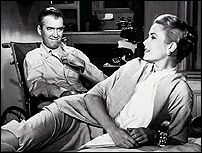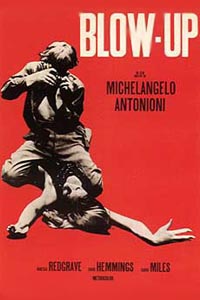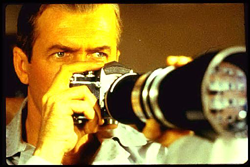This text has been submitted as an original contribution to cinetext on February 24, 2003. It is also available as PDF-document.
Avoiding the Masculine "Gaze"
Frustrated Homosexual Desire and the Eroticized Role of the Camera In Hitchcock's Rear Window and Antonioni's Blow Up
|
|
by Matthew M. Wylie |
In "Rear Window Ethics: Laura Mulvey and the Inverted Gaze", Robert Samuels attempts to point out and clarify a "series of misappropriations of Lacan's work [namely, the conceptual notion or difference of the 'gaze' and 'vision'] by other feminist scholars" (Hitchcock's Bitextuality 109). Samuels argues that a myriad of feminist scholarship in general, and Laura Mulvey's essay on Rear Window in particular, needs to reevaluate some of the fundamental concepts and approaches of Lacan's work-primarily how film / literary critics and theorists approach the idea of the "gaze" from a cinematic perspective. Moreover, Samuels seeks to "correct," with the intentions of solidifying feminist criticism, prior definitions as to what, for Lacan, the gaze actually is and what such a notion implies. As Samuels himself admonishes, the "gaze is therefore the object that is eluded by all forms of representation and vision; it is the lack or the limit that is inscribed into the phenomenology of consciousness" (111). Once Mulvey's definition of the Lacanian gaze is clarified and "corrected," Samuels endeavors to point out how it becomes inverted and directly linked, as in Rear Window, to voyeurism. Further, the Lacanian relationship between gaze and voyeurism plays for Samuels a direct role in the relationships that are formed in the film. While Samuels' primary analysis is consistent and quite valid, there seems to remain sizeable gaps in how his application of the gaze as it is helps to inform and delineate the frustrated relationships both formed and unformed within Rear Window.
As Mladen Dolar adequately points out in "A Father Who is Not Quite Dead", Hitchcock's "obsession with the gaze is omnipresent in his films" (in Everything You Always Wanted to Know About Lacan But Were Afraid to Ask Hitchcock 143). In turn, with Rear Window, the gaze becomes a catalyst for the unweaving of both the cinematic narrative and the collective community commentary that the apartment complex represents. Lacan depicts the relationship between voyeur and gaze-object as one that is defined and allocated by the gaze-object's ability to "fragment the illusion of the totalized body-image" (Samuels 112). Thus, the voyeur seeks, either intentionally or inadvertently, to find a fragmented, or dismembered object image-usually an image that the voyeur (subject) desires to identify with (what Samuels describes as "inverted narcissism"). Moreover, the voyeuristic process is one prescribed by the incoherency or lack that characterizes the gaze-object. According to Lacan then, it is this lack or absence that the voyeur finds intriguing:
"What he is trying to see, make no mistake, is the object as absence. What the voyeur is looking for and finds is merely a shadow behind the curtain . . . What he is looking for is not, as one says, the phallus, but precisely its absence" (Samuels 112).
In relation, much of the criticism on Rear Window focuses on Jefferies' unresponsive behavior toward Lisa Fremont (Grace Kelly). Obviously, we can detect notions of both homosexual and heterosexual desires in Jefferies' character and this can, perhaps, explain the rather inexplicable passive attitude he exhibits toward Lisa. Unfortunately though, it appears that Samuels' attempts to interpret Jefferies and the relationships he encounters via his masculine gaze under a schema that, appropriately enough, supports the bi-textual / bi-sexual thesis of his book, i.e., Hitchcock's Bitextuality. Rather than argue that Jefferies' voyeurism is an attempt to locate an "absence that will block his own homosexual desire," I will claim that Jefferies seeks, through rear window voyeurism, an identification and gratification that stems from fixating on the phallus, or body-totality of the male-in particular, Lars Thorwald. Moreover, by taking a brief comparative look at both Hitchcock's Rear Window and Antonioni's Blow up, I would like to point out that in these cinematic texts the male subject prefers to identify sexually with either another man or himself (masturbation) before he finds his desire stimulated or realized in the Other / Female.
Rear-Window
In Rear Window, it is Jefferies who adopts the position of voyeur. Immobile, bored, and most likely sexually frustrated as a result of both his immobility and repressed homosexual desires, Jefferies spends his recently acquired leisure time looking through a rear window at the situations and peoples in the apartment complex that lay across from his building. As Dolar claims, Jefferies' immobility reduces him to "a being of the gaze, confronted with the enigmatic signs in the building opposite his rear window" (In Everything You Always Wanted to Know About Lacan But Were Afraid to Ask Hitchcock 143). Samuels is accurate in claiming that the homoerotic desires of the film are repressed by the male characters(s), i.e. Samuels refers primarily to Jefferies, though I would like to extend this to the other male characters of the film. After the initial scene with Jefferies and Lisa, Hitchcock immediately informs us that frustrated homosexual desire is not embodied by Jefferies alone, but by the majority of the male characters within the film as well. We must only recall the young married couple, in which the male-husband character is constantly seen coming to and from the window wearing a distraught and unsatisfied facial expression. If, as with many of his films, Hitchcock is commenting on the institution of marriage with Rear Window, then it only seems appropriate that we can view both Jefferies' latent desire to avoid his marriage to Lisa and the young husband's responses to marital - sexual relations with his wife as homoerotic critiques of this traditionally heterosexual practice, i.e. the consummation of the wedding night. Further, we notice in Lars Thorwald the actual extreme reaction to male-female marriages, for Thorwald actually murders and dismembers his wife, finalizing his rebellion against one of the most common institutions of modern, Western culture-marriage.
Rear Window (Paramount, 1954).
The three men in the film (Jefferies, the young husband, and Lars) form a triangular and sequential pattern representing repressed homosexuality and the effects that such repression (in the form of the male-female marriage) has upon the individual. Moreover, Hitchcock allows the audience to view his homogenous pattern in a linear order: we are initially introduced to Jefferies and are made aware of his passivity toward Lisa, who we learn from Jefferies' nurse wants to enter into a marriage contract with Jefferies. We then catch a glimpse of the early married life in the young newlyweds, in which the male, as aforementioned, imitates as through a Lacanian mirror of the opposite apartment complex Jefferies' avoidance of Lisa. Finally, the cinematic narrative sequence shifts toward the mature, developed marriage, which of course ends in the tragic murder of wife by husband.
The sexual repression of the film is, for the most part, the driving impetus behind the film's narrative or plot. Jefferies not only avoids (continually!) the masculine gaze of Lars out of fear of being discovered as voyeur, but, according to a Lacanian analysis, out of the fear of forfeiting his own individual control of vision. Ironically enough, Jefferies' frustrated sexual desire is not fully realized until his control of vision is forfeited, or inverted. Throughout three-fourths of the film, Jefferies maintains a structured "intentionality" that leaves him in visionary control. It is not until Lars looks up into the apartment and spots Jefferies after the ring / police sequence that Jefferies becomes, inversely, the gaze-object. According to Lacan, this formulae indicates that "there is an inverse relation between the one who is looking and the one who is looked at. Furthermore, he [Lacan] places the subject that is looked at in the position of the object (a) in the form of the gaze" (Samuel 110). Jefferies does not display a fear of becoming the gaze-object simply because it implies a lack or absence of power, but because it accentuates his own homosexual desires and prevents him from keeping such desires repressed, private, un-known, and un-seen, especially from himself. As Samuels states, Jefferies' "constant attempts then to avoid having the killer see him, also represent his attempts at avoiding the acknowledgement of his repressed homosexuality" (116).
Of Vision Fields, Cameras, and Telephalluses
As aforementioned, the frustrated homosexual desire of the male subject within the film is accentuated on a variety of levels and Hitchcock introduces the audience to these conflicts through thematic phases (linear and sequential-see above diagram). However, I would like to further add and stress that the male subject's desire to avoid both marriage and heterosexual relations is done so at all costs, especially in Jefferies' case.
As several critics have noted, Jefferies' telephoto lens camera can be read as a phallus, or "telephallus." Used as the device by which Jefferies controls his field of vision and maintains his gaze (at least throughout most of the film), the camera becomes associated with the male sex organ, an anatomical presence that is lacking or absent in the female subject. Because Jefferies is immobile and invalidated as the male invalid of the film, he reverts to this substitute phallus as a means of re-establishing his own masculinity and establishing an extremely charged relationship with Lars Thorwald. As Samuels states, while Jefferies "cannot establish a physical relationship with Thorwald, he attempts to create a bond with him on a visual field" (120). Thus, the telephallus becomes, for the time being, Jefferies' substitute penis, which he will opt to touch and control rather than engage in sexual or even marital relations with Lisa. In other words, if Jefferies' repressed homosexual desires will not let him have another man physically, he would prefer to engage in the act of self-gratification or masturbation rather than in heterosexual sexual relations with another woman.
As with another cinematic text in which the telephallus / camera is employed as a device that perpetuates both the gaze and the plot of the narrative, Antonioni's Blow Up too exemplifies this idea of frustrated homosexuality and / or masturbation as a preference to female sexuality. With Blow Up, we must only recall our earliest impressions of Thomas and the relation he has with his camera, or telephallus. As he is photographing the blonde model in the film's initial sequence, he approaches her using verbal sexual innuendo; with each shot taken his language and demands become more and more eroticized until finally he completes his role of film-and has climaxed. Immediately afterward, Thomas gets up from his sexualized position with an air of indifference and apparent disgust, and leaves the female model lying on the floor as is.

Blowup (Bridge/MGM, 1966).
We notice this same pattern played out too in the studio scene between Thomas and Jane. After several attempts to plead her case with Thomas and retrieve the incriminating film, Jane offers herself sexually to Thomas, who, in response, walks toward her and snatches the film from her hand remarking that he will cut the desired negative for her. When he returns with the film, the scene attempts to take off where Thomas had left it, i.e., with Jane topless and offering sex. However, this encounter is interrupted by the arrival of yet another phallus in the object of the wooden propeller that Thomas had purchased from the antique shop. Needless to say, Thomas and Jane never copulate. The remainder of the film concentrates more on Thomas' uncovering of the mystery or crime through the use of his own substitute phallus, i.e. the camera.
We can read in Thomas' character similar patterns of frustrated homosexual desire that are to be found in the male characters of Rear Window. I anticipate oppositional arguments which will champion Thomas' heterosexuality, most likely referencing the scene with the two young, aspiring models and the allusions to Thomas' affair with the married woman. However, both instances are highly ambiguous and left incomplete. Antonioni does not actually show Thomas engage in the assumed m�nage-a-trois (unless this takes place in an uncut version that I have, unfortunately, not seen) and the frolicking that takes place within the studio is far more playful than it is sexual. Both before and after this scene, Thomas is observed literally with his pants on. As with the relationship between Thomas and the married woman, we are again left to question Thomas' heterosexual desire to be with women. While an intimate relationship is alluded to, Thomas never touches nor declares his feelings for her throughout the film. In fact, his only genuine reaction toward her comes when he walks in on her and the husband having sexual intercourse, in which Thomas is allowed, due to the sexual position (missionary), a better view or "gaze" of the naked, sexualized male body, rather than the female's. The audience is confused as to what Thomas' reaction truly is, for it appears to be one of both disgust and excitement and the awkwardly excessive amount of time that he spends in the doorway observing, as voyeur, the couple, begs us to question what emotions hide behind his somewhat unintelligible facial expression(s). Again, like Jefferies, Thomas' real enjoyment and preoccupation stems from his camera, i.e. his object of masturbation. Moreover, is it the camera, the telephallus, which the male subject in both films resorts to before he resorts to heterosexual intercourse. Additionally, it is the camera, or telephallus, which serves as the catalyst for the uncovering of a crime-again, in both films, a murder that takes place between male and female subjects.
Fin
Hitchcock's Rear Window and Antonioni's Blow Up serve as cinematic texts that present the audience or critic with a visual field of narrative that manifests the Lacanian relationship between voyeur and gaze-object. Moreover, such a dialectic allows for a myriad of textual and intertexual relationships to be observed and interpreted by the audience. As Samuels states, "in Hitchcock's works, we often find the representation of a straight heterosexual narrative that is couple with a visual bi-textual discourse" (121). In each case however, I believe it is safe to conclude that this "bi-textual discourse" is characterized by an overwhelmingly frustrated homosexual desire on the part of the male subjects. Further, we find not only the effect that the repression of homosexual desires has on both male and female subjects (and in Rear Window we find the most extreme cases-murder), but also how such repression or frustration contributes to the subject's control, or lack thereof, of his / her gaze.
Works Cited
Dolar, Mladen. "A Father Who is Not Quite Dead." Everything You Always Wanted To Know About Lacan But Were Afraid To Ask Hitchcock. New York: Verso, 1992.
Samuels, Roberts. "Rear Window Ethics: Laura Mulvey and the Inverted Gaze." Hitchcock's Bitextuality: Lacan, Feminisms, and Queer Theory. State University of New York Press: New York, 1998.

